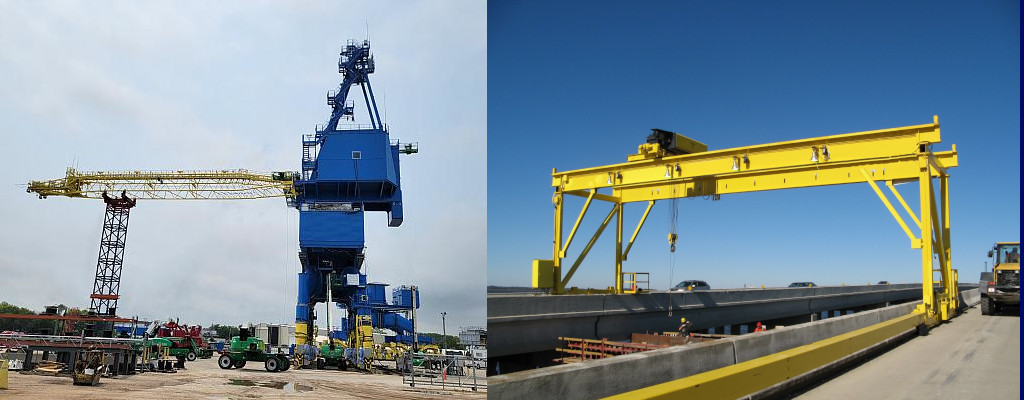Storm Brakes: Essential Safety Components in Rail Equipment

Storm Brakes: Essential Safety Components in Rail Equipment – A view from space of a Hurricane
Introduction
Why are Storm Brakes: Essential Safety Components in Rail Equipment? Storm brakes, sometimes referred to as rail clamps, play a pivotal role in securing heavy rail-mounted equipment against unforeseen environmental hazards, particularly strong winds. Given the enormous size and surface area of cranes and other rail equipment, the potential wind forces acting upon them can be considerable. This article will delve deep into the significance of storm brakes, their working mechanism, their application in various industries, and the types of equipment they are employed in.

Two Cranes fitted with Storm Brakes
When and Why are Storm Brakes Used?
Storm brakes are primarily used as a safety measure for rail-mounted equipment to prevent undesired movement due to external forces, such as strong winds. Equipment like cranes, stacker-reclaimers, and ship-loaders can have a substantial surface area. When subjected to high wind speeds, these surfaces can act like sails, catching wind and leading to uncontrolled movements. Such unplanned movements pose safety risks, including potential derailment or collisions. By using storm brakes, these equipment pieces can be firmly secured to their rails, ensuring they remain stationary even in adverse conditions.

Crane fitted with Storm Brakes / Rail Clamps
Calculations on Wind Forces
To appreciate the need for storm brakes, it’s essential to understand the physics behind wind forces acting on equipment. The force exerted by wind on a surface can be calculated using various factors. Factors can include:
1.) Effective velocity pressure of wind;
2.) Structural Importance Factors;
3.) Gust response factors;
4.) Velocity Pressure Exposure Coefficient;
5.) Shape Factor of the crane or structure (Round, Square or Lattice Structures);
6.) Shape aspect constant;
7.) Surface Element Diameter of least horizontal dimension;
8.) Surface Element Height dimension;
9.) Surface element mean height above ground;
10.) Solid Surface Area;
11.) Ratio of solid area / gross area.
For a crane with a large surface area, even moderate wind speeds can exert significant forces, making the use of storm brakes crucial.

CAD Drawings of different rail clamps
Failsafe Nature of Rail Clamps
The design of rail clamps generally emphasizes a failsafe mechanism. In situations where there might be a loss of power or system malfunction, the brakes are designed to remain engaged or immediately engage, ensuring equipment remains stationary. This inherent safety feature is crucial in preventing potential disasters in industrial settings. The types of rail clamps can included various actuation methods such as Pneumatic, Hydraulic, and Electric.
Two Main Types of Storm Brakes
1. Push Down Rail Brakes:
These brakes operate by utilizing the weight of the equipment they’re mounted on. When engaged, they push downward onto the rail, leveraging the equipment’s own weight to achieve a secure grip. They are simple in design and offer reliable performance due to the direct force application.

RB Series push down type Rail Brakes

As mounted on a Crane, push down type Rail Brake
2. Rail Clamps:
These brakes function by clamping onto the sides of the rails. They provide a robust grip by squeezing the rail from both sides, offering excellent stability. Their design is often more intricate than pushdown brakes but offers the advantage of evenly distributed clamping force.

STH Storm Brake / Rail Clamp
Rail Mounted Equipment Types:
Trippers: These are conveyor systems that can be moved or ‘trip’ along rails to deposit materials at designated spots for bulk material handling.

Conveyor Tripper Clamp / Gripper
Stacker-reclaimers: Dual purpose machines that stack bulk material and then reclaim it when needed, often used in bulk handling ports and large industrial plants.
Ship-loaders / Unloaders: Used in ports to load bulk material like coal or grain onto ships.
Types of Cranes and Industries Employing Rail Clamps:
1. Gantry Cranes: Widely used in shipyards and container terminals.
2. Overhead Cranes: Found in manufacturing facilities and warehouses.
3. Tower Cranes: Predominantly used in construction sites.
4. Portal Cranes: Commonly found in ports for ship loading and unloading.
5. Space Vehicle Cranes: Payload Cranes for moving and assembling space vehicles.

Electric Operated Explosion Proof Rail Clamp / Storm Brake
Industries:
Coal: For handling, loading, and unloading coal at ports and coal processing plants.
Sulfur: In facilities where sulfur is processed or exported as a bulk material.
Potash: At ports where potash is loaded or unloaded and in processing plants.
Iron Ore: In mining facilities and ports where iron ore is handled.
Bulk Materials: All mining operations of various bulk materials can utilize rail clamps on their conveyor tripper systems.
Conclusion
Storm brakes, with their heavy duty and failsafe designs, are instrumental in ensuring the safety and efficiency of rail mounted equipment. By preventing uncontrolled movements during extreme wind and storm events, they protect both the equipment and the personnel operating them. As industries expand and equipment gets larger, the need for reliable storm brakes becomes ever more critical. Their versatility across various industries, from coal to iron ore, underscores their importance in maintaining safe and efficient operations.
Looking for more information on Storm Brakes and Rail Clamps?
Contact us or fill in one of our online Rail Clamp / Storm Brake forms and we will get back to you shortly!



Storm Brakes: Essential Safety Components in Rail Equipment – A view from space of a Hurricane
Introduction
Why are Storm Brakes: Essential Safety Components in Rail Equipment? Storm brakes, sometimes referred to as rail clamps, play a pivotal role in securing heavy rail-mounted equipment against unforeseen environmental hazards, particularly strong winds. Given the enormous size and surface area of cranes and other rail equipment, the potential wind forces acting upon them can be considerable. This article will delve deep into the significance of storm brakes, their working mechanism, their application in various industries, and the types of equipment they are employed in.

Two Cranes fitted with Storm Brakes
When and Why are Storm Brakes Used?
Storm brakes are primarily used as a safety measure for rail-mounted equipment to prevent undesired movement due to external forces, such as strong winds. Equipment like cranes, stacker-reclaimers, and ship-loaders can have a substantial surface area. When subjected to high wind speeds, these surfaces can act like sails, catching wind and leading to uncontrolled movements. Such unplanned movements pose safety risks, including potential derailment or collisions. By using storm brakes, these equipment pieces can be firmly secured to their rails, ensuring they remain stationary even in adverse conditions.

Crane fitted with Storm Brakes / Rail Clamps
Calculations on Wind Forces
To appreciate the need for storm brakes, it’s essential to understand the physics behind wind forces acting on equipment. The force exerted by wind on a surface can be calculated using various factors. Factors can include:
1.) Effective velocity pressure of wind;
2.) Structural Importance Factors;
3.) Gust response factors;
4.) Velocity Pressure Exposure Coefficient;
5.) Shape Factor of the crane or structure (Round, Square or Lattice Structures);
6.) Shape aspect constant;
7.) Surface Element Diameter of least horizontal dimension;
8.) Surface Element Height dimension;
9.) Surface element mean height above ground;
10.) Solid Surface Area;
11.) Ratio of solid area / gross area.
For a crane with a large surface area, even moderate wind speeds can exert significant forces, making the use of storm brakes crucial.

CAD Drawings of different rail clamps
Failsafe Nature of Rail Clamps
The design of rail clamps generally emphasizes a failsafe mechanism. In situations where there might be a loss of power or system malfunction, the brakes are designed to remain engaged or immediately engage, ensuring equipment remains stationary. This inherent safety feature is crucial in preventing potential disasters in industrial settings. The types of rail clamps can included various actuation methods such as Pneumatic, Hydraulic, and Electric.
Two Main Types of Storm Brakes
1. Push Down Rail Brakes:
These brakes operate by utilizing the weight of the equipment they’re mounted on. When engaged, they push downward onto the rail, leveraging the equipment’s own weight to achieve a secure grip. They are simple in design and offer reliable performance due to the direct force application.

RB Series push down type Rail Brakes

As mounted on a Crane, push down type Rail Brake
2. Rail Clamps:
These brakes function by clamping onto the sides of the rails. They provide a robust grip by squeezing the rail from both sides, offering excellent stability. Their design is often more intricate than pushdown brakes but offers the advantage of evenly distributed clamping force.

STH Storm Brake / Rail Clamp
Rail Mounted Equipment Types:
Trippers: These are conveyor systems that can be moved or ‘trip’ along rails to deposit materials at designated spots for bulk material handling.

Conveyor Tripper Clamp / Gripper
Stacker-reclaimers: Dual purpose machines that stack bulk material and then reclaim it when needed, often used in bulk handling ports and large industrial plants.
Ship-loaders / Unloaders: Used in ports to load bulk material like coal or grain onto ships.
Types of Cranes and Industries Employing Rail Clamps:
1. Gantry Cranes: Widely used in shipyards and container terminals.
2. Overhead Cranes: Found in manufacturing facilities and warehouses.
3. Tower Cranes: Predominantly used in construction sites.
4. Portal Cranes: Commonly found in ports for ship loading and unloading.
5. Space Vehicle Cranes: Payload Cranes for moving and assembling space vehicles.

Electric Operated Explosion Proof Rail Clamp / Storm Brake
Industries:
Coal: For handling, loading, and unloading coal at ports and coal processing plants.
Sulfur: In facilities where sulfur is processed or exported as a bulk material.
Potash: At ports where potash is loaded or unloaded and in processing plants.
Iron Ore: In mining facilities and ports where iron ore is handled.
Bulk Materials: All mining operations of various bulk materials can utilize rail clamps on their conveyor tripper systems.
Conclusion
Storm brakes, with their heavy duty and failsafe designs, are instrumental in ensuring the safety and efficiency of rail mounted equipment. By preventing uncontrolled movements during extreme wind and storm events, they protect both the equipment and the personnel operating them. As industries expand and equipment gets larger, the need for reliable storm brakes becomes ever more critical. Their versatility across various industries, from coal to iron ore, underscores their importance in maintaining safe and efficient operations.
Looking for more information on Storm Brakes and Rail Clamps?
Contact us or fill in one of our online Rail Clamp / Storm Brake forms and we will get back to you shortly!
